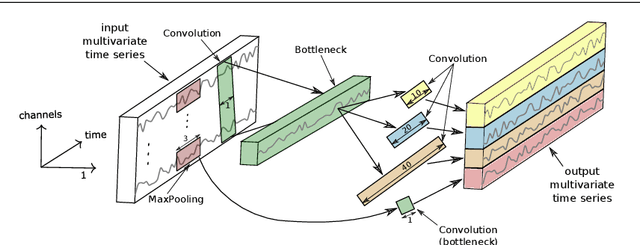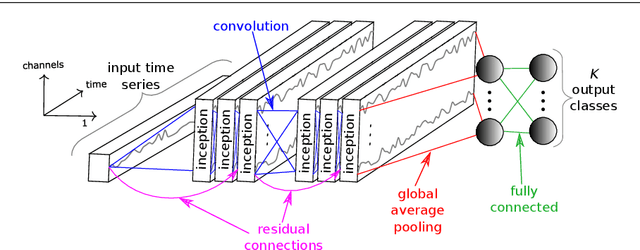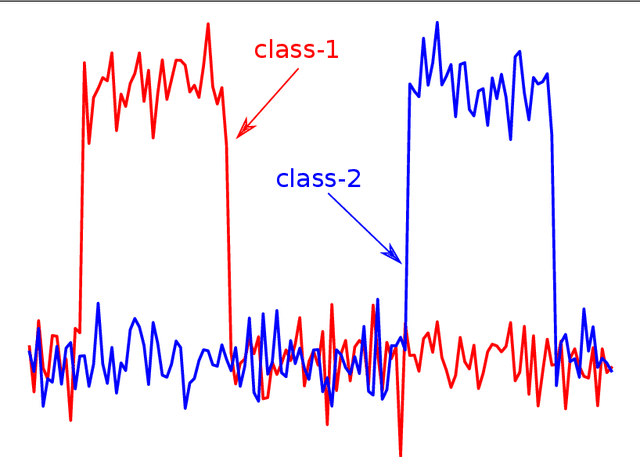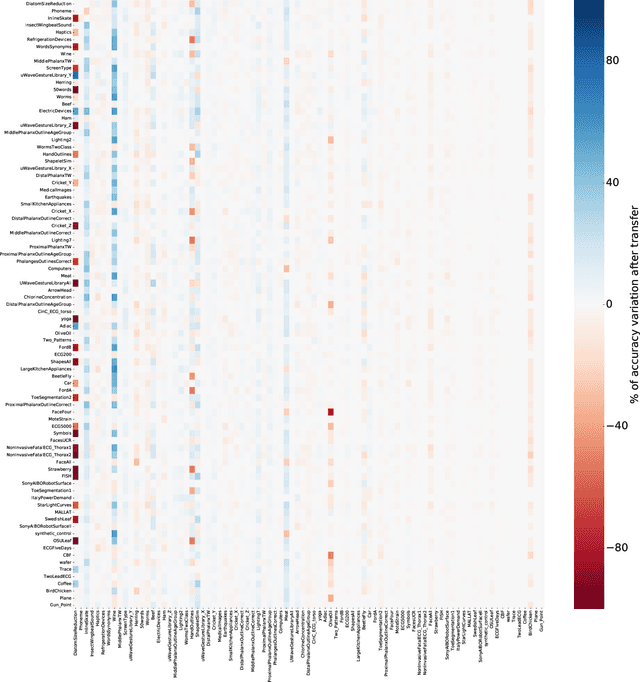Jonathan Weber
Look Into the LITE in Deep Learning for Time Series Classification
Sep 04, 2024Abstract:Deep learning models have been shown to be a powerful solution for Time Series Classification (TSC). State-of-the-art architectures, while producing promising results on the UCR and the UEA archives , present a high number of trainable parameters. This can lead to long training with high CO2 emission, power consumption and possible increase in the number of FLoating-point Operation Per Second (FLOPS). In this paper, we present a new architecture for TSC, the Light Inception with boosTing tEchnique (LITE) with only 2.34% of the number of parameters of the state-of-the-art InceptionTime model, while preserving performance. This architecture, with only 9, 814 trainable parameters due to the usage of DepthWise Separable Convolutions (DWSC), is boosted by three techniques: multiplexing, custom filters, and dilated convolution. The LITE architecture, trained on the UCR, is 2.78 times faster than InceptionTime and consumes 2.79 times less CO2 and power. To evaluate the performance of the proposed architecture on multivariate time series data, we adapt LITE to handle multivariate time series, we call this version LITEMV. To bring theory into application, we also conducted experiments using LITEMV on multivariate time series representing human rehabilitation movements, showing that LITEMV not only is the most efficient model but also the best performing for this application on the Kimore dataset, a skeleton based human rehabilitation exercises dataset. Moreover, to address the interpretability of LITEMV, we present a study using Class Activation Maps to understand the classification decision taken by the model during evaluation.
Establishing a Unified Evaluation Framework for Human Motion Generation: A Comparative Analysis of Metrics
May 13, 2024Abstract:The development of generative artificial intelligence for human motion generation has expanded rapidly, necessitating a unified evaluation framework. This paper presents a detailed review of eight evaluation metrics for human motion generation, highlighting their unique features and shortcomings. We propose standardized practices through a unified evaluation setup to facilitate consistent model comparisons. Additionally, we introduce a novel metric that assesses diversity in temporal distortion by analyzing warping diversity, thereby enhancing the evaluation of temporal data. We also conduct experimental analyses of three generative models using a publicly available dataset, offering insights into the interpretation of each metric in specific case scenarios. Our goal is to offer a clear, user-friendly evaluation framework for newcomers, complemented by publicly accessible code.
Finding Foundation Models for Time Series Classification with a PreText Task
Nov 24, 2023Abstract:Over the past decade, Time Series Classification (TSC) has gained an increasing attention. While various methods were explored, deep learning - particularly through Convolutional Neural Networks (CNNs)-stands out as an effective approach. However, due to the limited availability of training data, defining a foundation model for TSC that overcomes the overfitting problem is still a challenging task. The UCR archive, encompassing a wide spectrum of datasets ranging from motion recognition to ECG-based heart disease detection, serves as a prime example for exploring this issue in diverse TSC scenarios. In this paper, we address the overfitting challenge by introducing pre-trained domain foundation models. A key aspect of our methodology is a novel pretext task that spans multiple datasets. This task is designed to identify the originating dataset of each time series sample, with the goal of creating flexible convolution filters that can be applied across different datasets. The research process consists of two phases: a pre-training phase where the model acquires general features through the pretext task, and a subsequent fine-tuning phase for specific dataset classifications. Our extensive experiments on the UCR archive demonstrate that this pre-training strategy significantly outperforms the conventional training approach without pre-training. This strategy effectively reduces overfitting in small datasets and provides an efficient route for adapting these models to new datasets, thus advancing the capabilities of deep learning in TSC.
ShapeDBA: Generating Effective Time Series Prototypes using ShapeDTW Barycenter Averaging
Sep 28, 2023Abstract:Time series data can be found in almost every domain, ranging from the medical field to manufacturing and wireless communication. Generating realistic and useful exemplars and prototypes is a fundamental data analysis task. In this paper, we investigate a novel approach to generating realistic and useful exemplars and prototypes for time series data. Our approach uses a new form of time series average, the ShapeDTW Barycentric Average. We therefore turn our attention to accurately generating time series prototypes with a novel approach. The existing time series prototyping approaches rely on the Dynamic Time Warping (DTW) similarity measure such as DTW Barycentering Average (DBA) and SoftDBA. These last approaches suffer from a common problem of generating out-of-distribution artifacts in their prototypes. This is mostly caused by the DTW variant used and its incapability of detecting neighborhood similarities, instead it detects absolute similarities. Our proposed method, ShapeDBA, uses the ShapeDTW variant of DTW, that overcomes this issue. We chose time series clustering, a popular form of time series analysis to evaluate the outcome of ShapeDBA compared to the other prototyping approaches. Coupled with the k-means clustering algorithm, and evaluated on a total of 123 datasets from the UCR archive, our proposed averaging approach is able to achieve new state-of-the-art results in terms of Adjusted Rand Index.
An Approach to Multiple Comparison Benchmark Evaluations that is Stable Under Manipulation of the Comparate Set
May 19, 2023Abstract:The measurement of progress using benchmarks evaluations is ubiquitous in computer science and machine learning. However, common approaches to analyzing and presenting the results of benchmark comparisons of multiple algorithms over multiple datasets, such as the critical difference diagram introduced by Dem\v{s}ar (2006), have important shortcomings and, we show, are open to both inadvertent and intentional manipulation. To address these issues, we propose a new approach to presenting the results of benchmark comparisons, the Multiple Comparison Matrix (MCM), that prioritizes pairwise comparisons and precludes the means of manipulating experimental results in existing approaches. MCM can be used to show the results of an all-pairs comparison, or to show the results of a comparison between one or more selected algorithms and the state of the art. MCM is implemented in Python and is publicly available.
InceptionTime: Finding AlexNet for Time Series Classification
Sep 13, 2019



Abstract:Time series classification (TSC) is the area of machine learning interested in learning how to assign labels to time series. The last few decades of work in this area have led to significant progress in the accuracy of classifiers, with the state of the art now represented by the HIVE-COTE algorithm. While extremely accurate, HIVE-COTE is infeasible to use in many applications because of its very high training time complexity in O(N^2*T^4) for a dataset with N time series of length T. For example, it takes HIVE-COTE more than 72,000s to learn from a small dataset with N=700 time series of short length T=46. Deep learning, on the other hand, has now received enormous attention because of its high scalability and state-of-the-art accuracy in computer vision and natural language processing tasks. Deep learning for TSC has only very recently started to be explored, with the first few architectures developed over the last 3 years only. The accuracy of deep learning for TSC has been raised to a competitive level, but has not quite reached the level of HIVE-COTE. This is what this paper achieves: outperforming HIVE-COTE's accuracy together with scalability. We take an important step towards finding the AlexNet network for TSC by presenting InceptionTime---an ensemble of deep Convolutional Neural Network (CNN) models, inspired by the Inception-v4 architecture. Our experiments show that InceptionTime slightly outperforms HIVE-COTE with a win/draw/loss on the UCR archive of 40/6/39. Not only is InceptionTime more accurate, but it is much faster: InceptionTime learns from that same dataset with 700 time series in 2,300s but can also learn from a dataset with 8M time series in 13 hours, a quantity of data that is fully out of reach of HIVE-COTE.
Accurate and interpretable evaluation of surgical skills from kinematic data using fully convolutional neural networks
Aug 20, 2019



Abstract:Purpose: Manual feedback from senior surgeons observing less experienced trainees is a laborious task that is very expensive, time-consuming and prone to subjectivity. With the number of surgical procedures increasing annually, there is an unprecedented need to provide an accurate, objective and automatic evaluation of trainees' surgical skills in order to improve surgical practice. Methods: In this paper, we designed a convolutional neural network (CNN) to classify surgical skills by extracting latent patterns in the trainees' motions performed during robotic surgery. The method is validated on the JIGSAWS dataset for two surgical skills evaluation tasks: classification and regression. Results: Our results show that deep neural networks constitute robust machine learning models that are able to reach new competitive state-of-the-art performance on the JIGSAWS dataset. While we leveraged from CNNs' efficiency, we were able to minimize its black-box effect using the class activation map technique. Conclusions: This characteristic allowed our method to automatically pinpoint which parts of the surgery influenced the skill evaluation the most, thus allowing us to explain a surgical skill classification and provide surgeons with a novel personalized feedback technique. We believe this type of interpretable machine learning model could integrate within "Operation Room 2.0" and support novice surgeons in improving their skills to eventually become experts.
Automatic alignment of surgical videos using kinematic data
Apr 26, 2019



Abstract:Over the past one hundred years, the classic teaching methodology of "see one, do one, teach one" has governed the surgical education systems worldwide. With the advent of Operation Room 2.0, recording video, kinematic and many other types of data during the surgery became an easy task, thus allowing artificial intelligence systems to be deployed and used in surgical and medical practice. Recently, surgical videos has been shown to provide a structure for peer coaching enabling novice trainees to learn from experienced surgeons by replaying those videos. However, the high inter-operator variability in surgical gesture duration and execution renders learning from comparing novice to expert surgical videos a very difficult task. In this paper, we propose a novel technique to align multiple videos based on the alignment of their corresponding kinematic multivariate time series data. By leveraging the Dynamic Time Warping measure, our algorithm synchronizes a set of videos in order to show the same gesture being performed at different speed. We believe that the proposed approach is a valuable addition to the existing learning tools for surgery.
Transfer learning for time series classification
Nov 05, 2018



Abstract:Transfer learning for deep neural networks is the process of first training a base network on a source dataset, and then transferring the learned features (the network's weights) to a second network to be trained on a target dataset. This idea has been shown to improve deep neural network's generalization capabilities in many computer vision tasks such as image recognition and object localization. Apart from these applications, deep Convolutional Neural Networks (CNNs) have also recently gained popularity in the Time Series Classification (TSC) community. However, unlike for image recognition problems, transfer learning techniques have not yet been investigated thoroughly for the TSC task. This is surprising as the accuracy of deep learning models for TSC could potentially be improved if the model is fine-tuned from a pre-trained neural network instead of training it from scratch. In this paper, we fill this gap by investigating how to transfer deep CNNs for the TSC task. To evaluate the potential of transfer learning, we performed extensive experiments using the UCR archive which is the largest publicly available TSC benchmark containing 85 datasets. For each dataset in the archive, we pre-trained a model and then fine-tuned it on the other datasets resulting in 7140 different deep neural networks. These experiments revealed that transfer learning can improve or degrade the model's predictions depending on the dataset used for transfer. Therefore, in an effort to predict the best source dataset for a given target dataset, we propose a new method relying on Dynamic Time Warping to measure inter-datasets similarities. We describe how our method can guide the transfer to choose the best source dataset leading to an improvement in accuracy on 71 out of 85 datasets.
Deep learning for time series classification: a review
Sep 12, 2018



Abstract:Time Series Classification (TSC) is an important and challenging problem in data mining. With the increase of time series data availability, hundreds of TSC algorithms have been proposed. Among these methods, only a few have considered Deep Neural Networks (DNNs) to perform this task. This is surprising as deep learning has seen very successful applications in the last years. DNNs have indeed revolutionized the field of computer vision especially with the advent of novel deeper architectures such as Residual and Convolutional Neural Networks. Apart from images, sequential data such as text and audio can also be processed with DNNs to reach state of the art performance for document classification and speech recognition. In this article, we study the current state of the art performance of deep learning algorithms for TSC by presenting an empirical study of the most recent DNN architectures for TSC. We give an overview of the most successful deep learning applications in various time series domains under a unified taxonomy of DNNs for TSC. We also provide an open source deep learning framework to the TSC community where we implemented each of the compared approaches and evaluated them on a univariate TSC benchmark (the UCR archive) and 12 multivariate time series datasets. By training 8,730 deep learning models on 97 time series datasets, we propose the most exhaustive study of DNNs for TSC to date.
 Add to Chrome
Add to Chrome Add to Firefox
Add to Firefox Add to Edge
Add to Edge